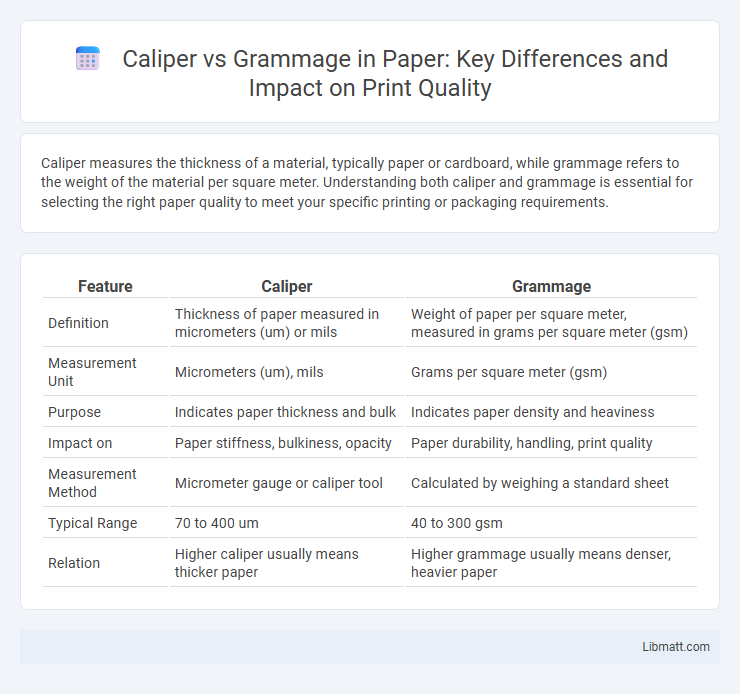Caliper measures the thickness of a material, typically paper or cardboard, while grammage refers to the weight of the material per square meter. Understanding both caliper and grammage is essential for selecting the right paper quality to meet your specific printing or packaging requirements.
Table of Comparison
| Feature | Caliper | Grammage |
|---|---|---|
| Definition | Thickness of paper measured in micrometers (um) or mils | Weight of paper per square meter, measured in grams per square meter (gsm) |
| Measurement Unit | Micrometers (um), mils | Grams per square meter (gsm) |
| Purpose | Indicates paper thickness and bulk | Indicates paper density and heaviness |
| Impact on | Paper stiffness, bulkiness, opacity | Paper durability, handling, print quality |
| Measurement Method | Micrometer gauge or caliper tool | Calculated by weighing a standard sheet |
| Typical Range | 70 to 400 um | 40 to 300 gsm |
| Relation | Higher caliper usually means thicker paper | Higher grammage usually means denser, heavier paper |
Introduction to Caliper and Grammage
Caliper measures the thickness of paper or board, typically expressed in microns or mils, providing insight into material stiffness and bulk. Grammage quantifies paper weight in grams per square meter (gsm), indicating density and durability for various applications. Understanding both caliper and grammage helps you select the right paper quality for printing, packaging, or design projects.
Definition of Caliper in Paper Measurement
Caliper in paper measurement refers to the thickness of a single sheet of paper, typically expressed in microns or thousandths of an inch. It directly affects the stiffness, opacity, and printability of the paper, making it a critical factor in quality control and paper specification. Unlike grammage, which measures weight per unit area (g/m2), caliper provides a precise indication of the paper's physical thickness independent of its weight.
Understanding Grammage: What It Means
Grammage refers to the weight of paper measured in grams per square meter (gsm), indicating its density and sturdiness. It directly affects the paper's thickness, print quality, and durability, helping you choose the right material for your project. Understanding grammage ensures you select paper that meets your needs for weight and texture, distinguishing it from caliper, which measures thickness in microns or mils.
How Caliper Is Measured
Caliper is measured using a micrometer or a specific thickness gauge, indicating the thickness of paper or board in thousandths of an inch (mils) or microns. This measurement directly impacts the rigidity and feel of the material, critical for packaging and printing quality control. Your choice between caliper and grammage will depend on whether thickness or weight per unit area is more relevant to your application's requirements.
The Process of Determining Grammage
Grammage is determined by measuring the mass of a paper sample per unit area, typically expressed in grams per square meter (gsm). The process involves cutting a precise size of paper, weighing it on a high-accuracy scale, and then calculating the grammage using the formula: weight (grams) divided by area (square meters). Unlike caliper, which measures thickness, grammage provides essential data about paper density and weight, influencing print quality and material performance.
Key Differences Between Caliper and Grammage
Caliper measures the thickness of paper or board in microns or mils, reflecting its physical depth, while grammage represents the mass per unit area in grams per square meter (gsm), indicating the paper's density and weight. Caliper directly affects the paper's stiffness and bulk, whereas grammage is crucial for strength and print quality. Understanding both parameters is essential for selecting the right paper for printing, packaging, or industrial applications.
Importance of Caliper in Printing and Packaging
Caliper measures the thickness of paper or board, directly impacting print quality, packaging durability, and machine runnability, while grammage refers to the weight per square meter, influencing stiffness and robustness. In printing and packaging, precise caliper control ensures consistent ink absorption, accurate folding, and proper dimensioning, critical for maintaining product integrity and appearance. Your choice of caliper affects material compatibility with printing presses and packaging equipment, optimizing production efficiency and cost-effectiveness.
When to Choose Grammage Over Caliper
Choose grammage over caliper when the weight and thickness consistency of paper directly impacts printing quality and cost efficiency. Grammage measures the paper's density in grams per square meter (gsm), offering a precise indication of durability and feel, important for packaging, brochures, or business cards. Your decision should prioritize grammage when material strength and opacity are critical factors in the final product's performance.
Industry Applications of Caliper and Grammage
Caliper and grammage serve distinct purposes across various industry applications; caliper measures the thickness of paper and packaging materials critical for printing precision and packaging durability, while grammage quantifies the weight per unit area, influencing product quality and cost-efficiency in paper manufacturing, printing, and textile sectors. In packaging, caliper ensures protection and stacking strength, whereas grammage determines material density and sturdiness for shipping and product presentation. Your choice between caliper and grammage depends on specific industry requirements such as durability, print quality, and material efficiency.
Conclusion: Choosing the Right Paper Measurement
Caliper measures the thickness of paper in thousandths of an inch, while grammage indicates its weight in grams per square meter (gsm), both essential for determining paper quality. Your choice depends on the project's requirements for sturdiness, texture, and print quality, with caliper providing insight into paper thickness and grammage reflecting density. Balancing these measurements ensures optimal paper performance, whether for printing, packaging, or crafting needs.
caliper vs grammage Infographic

 libmatt.com
libmatt.com